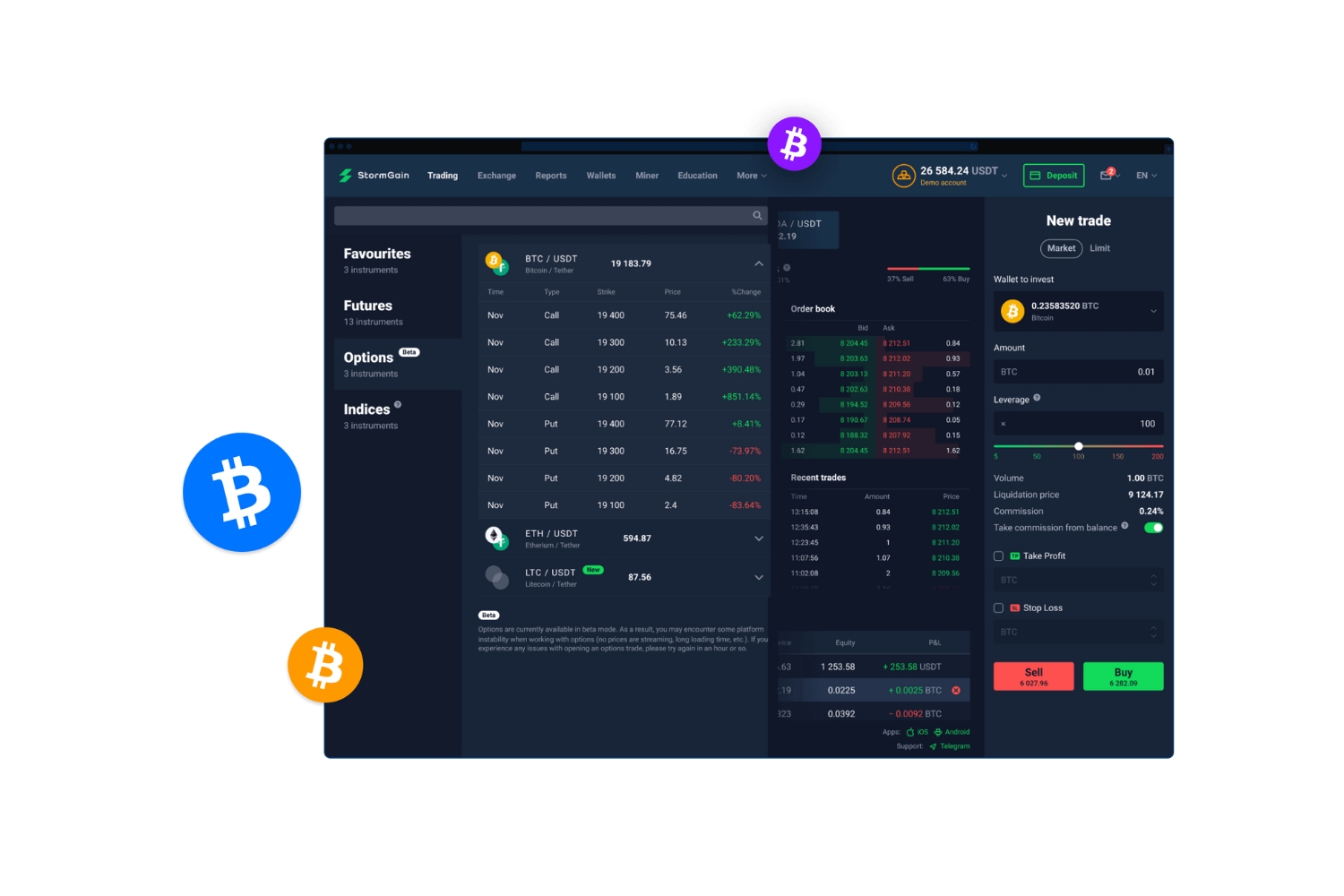Introduction
Welcome to the exciting world of options trading! If you’re looking to diversify your investment portfolio or explore new opportunities in the financial market, options trading can offer you a wealth of possibilities. Whether you’re a seasoned trader or a beginner just starting out, this article will provide you with a comprehensive guide on how to get started with options trading.
With options trading, you have the opportunity to purchase or sell a specific asset, known as the underlying asset, at a predetermined price and within a specified timeframe. This unique financial instrument provides the flexibility to profit from market movements, regardless of whether the price of the underlying asset is rising or falling.
Options trading can be an excellent way to manage risk and potentially generate significant returns. However, it is essential to have a solid understanding of how options work and the various strategies involved. In this article, we will delve into the basics of options trading, the benefits it offers, the different types of options available, and the strategies you can employ to maximize your profits.
Whether you’re an investor seeking income, capital appreciation, or both, options trading can play a crucial role in achieving your financial goals. By gaining insights into the market and effectively utilizing options strategies, you can take advantage of market volatility to generate consistent profits. However, it’s important to note that options trading does involve risks, and it’s essential to approach it with a well-thought-out plan and risk management strategy.
Throughout this article, we will also provide guidance on how to open an options trading account, choose the right options trading platform, and share some tips for successful options trading. By the end of this guide, you will have a solid foundation to embark on your options trading journey with confidence.
So, without further ado, let’s dive into the fascinating world of options trading and explore the endless possibilities it offers!
Understanding Options Trading
Options trading is a derivative market that allows traders to make speculative bets on the future price movements of underlying assets, such as stocks, commodities, or currencies. Unlike traditional buying and selling of assets, options trading provides traders with the right, but not the obligation, to buy or sell the underlying asset at a predetermined price, known as the strike price, within a specific period of time.
There are two main types of options: call options and put options. A call option gives the holder the right to buy the underlying asset at the strike price, while a put option gives the holder the right to sell the underlying asset at the strike price. Traders can buy options contracts to speculate on price increases (buying call options) or price decreases (buying put options).
One key concept in options trading is the expiration date. This is the date at which the option contract expires and becomes invalid. Traders can choose options contracts with different expiration dates, allowing them to take positions on short-term or long-term price movements.
Options trading also involves understanding and analyzing the option’s price, known as the premium. The premium is determined based on several factors, including the current price of the underlying asset, the strike price, the time remaining until expiration, and market volatility.
The primary reasons investors engage in options trading are to speculate on price movements, hedge existing positions, generate income through writing options, and implement complex trading strategies.
It’s important to note that options trading can be complex and requires a solid understanding of the underlying assets and market dynamics. Traders need to conduct thorough research, analyze market trends, and develop strategies that align with their risk tolerance and investment objectives.
By understanding the basics of options trading, you can take advantage of the flexibility and profit potential this financial instrument offers. In the following sections, we will delve deeper into the benefits of options trading, the different types of options available, and the strategies you can employ to optimize your trading outcomes.
Benefits of Options Trading
Options trading provides traders with numerous benefits that can enhance their investment strategies and potentially increase their returns. Let’s take a closer look at some of the key advantages of options trading.
- Leverage: Options allow traders to control a larger position of an underlying asset with a smaller capital outlay. This ability to leverage their investments can amplify potential gains, offering a greater return on investment compared to trading the underlying asset itself.
- Hedging: Options provide a valuable tool for hedging existing positions in the market. Traders can use options contracts to protect against potential losses in their portfolio by taking opposite positions. For example, if a trader holds a portfolio of stocks, they can purchase put options to offset potential declines in the stock prices.
- Income Generation: Options trading allows traders to generate income through writing options contracts. By selling call or put options, traders receive premiums from buyers, which can add to their overall investment returns. This strategy is particularly useful in sideways or low-volatility markets, where options premiums are typically higher.
- Profit Potential in Any Market Direction: Unlike traditional stock trading, options trading offers profit potential in both rising and falling markets. Traders can buy call options to profit from upward price movements or buy put options to benefit from downward price movements. This versatility provides traders with more opportunities to generate profits, regardless of market conditions.
- Risk Management: Options trading allows traders to define and limit their risk exposure. With options, traders have the flexibility to set stop-loss levels and use various risk management strategies to protect their capital. This enables traders to have more control over their risk and minimize potential losses.
These are just a few of the benefits that options trading offers. It’s important to note that options trading is not without risks, and traders should thoroughly educate themselves before engaging in this market. However, when approached with proper knowledge and strategies, options trading can provide an array of advantages to traders seeking to diversify their portfolios and optimize their investment opportunities.
Types of Options
Options trading provides traders with a variety of options contracts to choose from, each with its own unique characteristics and strategies. Let’s explore the two main types of options: call options and put options.
- Call Options: A call option gives the holder the right, but not the obligation, to buy the underlying asset at a specified price (strike price) within a specific timeframe. Call options are typically used when traders expect the price of the underlying asset to rise. By purchasing call options, traders can profit from the price increase of the underlying asset without actually owning it.
- Put Options: A put option gives the holder the right, but not the obligation, to sell the underlying asset at a specified price (strike price) within a specific timeframe. Put options are commonly used when traders anticipate the price of the underlying asset to fall. By purchasing put options, traders can profit from the price decrease of the underlying asset without actually owning it.
Additionally, options contracts can be classified based on their expiration dates:
- Short-term Options: Short-term options contracts typically have expiration dates within a month or less. These options are often used for quick trades and taking advantage of short-term market movements.
- Long-term Options: Long-term options have expiration dates that extend beyond a month, often up to a year or more. These options allow traders to take positions on long-term trends and have more time for their predictions to unfold.
Moreover, options contracts can be further categorized into:
- American Options: American options can be exercised at any time before the expiration date. This gives traders more flexibility in managing their positions and capturing profits.
- European Options: European options can only be exercised at the expiration date. Traders do not have the freedom to exercise the option before the predetermined date.
Understanding these different types of options is essential for implementing the right strategies and taking advantage of market opportunities. Each type of option has its own unique characteristics and potential profit outcomes, allowing traders to tailor their trading approach based on their market view and risk appetite.
Basic Options Trading Strategies
Options trading offers a wide range of strategies that traders can employ to capitalize on various market scenarios. While there are countless strategies available, let’s explore some of the basic options trading strategies that can help you get started.
- Covered Call: This strategy involves owning the underlying asset and writing (selling) a call option on that asset. Traders can collect premiums from selling the call option, which can help offset potential losses in the underlying asset if its price declines.
- Protective Put: This strategy involves purchasing a put option on an underlying asset that you already own. By buying a put option, you protect your position from potential downside risk. If the price of the asset drops, the put option will increase in value, offsetting the losses in the underlying asset.
- Long Call: With this strategy, traders buy call options when they anticipate the price of the underlying asset to rise. By purchasing call options, traders can participate in the upward price movement of the asset with limited risk, as the maximum loss is limited to the premium paid for the call option.
- Long Put: This strategy involves buying put options to profit from a decrease in the price of the underlying asset. By purchasing put options, traders can benefit from downward price movements while limiting their risk to the premium paid for the put option.
- Bull Call Spread: This strategy involves buying a call option with a lower strike price and simultaneously selling a call option with a higher strike price. The objective is to profit from a moderate increase in the price of the underlying asset. The premium received from selling the call option helps offset the cost of buying the lower strike price call option.
- Bear Put Spread: This strategy involves buying a put option with a higher strike price and simultaneously selling a put option with a lower strike price. The goal is to profit from a moderate decrease in the price of the underlying asset. The premium received from selling the put option helps offset the cost of buying the higher strike price put option.
These are just a few basic options trading strategies to consider. It’s important to remember that options trading involves risks, and traders should thoroughly understand the potential outcomes and manage their positions accordingly. As you gain experience and confidence in options trading, you can explore more advanced strategies and combinations to further optimize your trading outcomes.
Advanced Options Trading Strategies
For experienced traders looking to further enhance their options trading skills, there are a variety of advanced strategies available. These strategies can provide more sophisticated ways to take advantage of market conditions and potential price movements. Let’s explore some of these advanced options trading strategies.
- Straddle: This strategy involves simultaneously buying a call option and a put option with the same strike price and expiration date. Traders use the straddle strategy when they expect significant price volatility but are uncertain about the direction of the price movement. The goal is to profit from a substantial price swing in either direction.
- Strangle: Similar to the straddle strategy, the strangle strategy involves buying a call option and a put option, but with different strike prices. The strike price for the put option is typically lower than the strike price for the call option. Traders use the strangle strategy when they expect significant price movement but are unsure about the direction. This strategy allows traders to profit from a sharp move in either direction.
- Butterfly Spread: With this strategy, traders combine both a bull spread and a bear spread by simultaneously buying and selling call or put options at different strike prices. The butterfly spread strategy aims to capitalize on a narrow range of price movement in the underlying asset. It involves three strike prices and can be constructed using either all calls or all puts.
- Iron Condor: The iron condor strategy combines a bull put spread and a bear call spread. Traders use this strategy when they expect the price of the underlying asset to trade within a specific range for the duration of the options contracts. The goal is to earn premium income from selling both the call and put options while limiting potential losses through the spread positions.
- Calendar Spread: Also known as a time spread, this strategy involves simultaneously buying and selling options contracts with the same strike price but different expiration dates. Traders use the calendar spread strategy when they expect minimal price movement in the underlying asset. The aim is to profit from the different rates of time decay between the options contracts.
- Ratio Spread: This strategy involves buying and selling options contracts with a differing number of contracts or strike prices. Traders use the ratio spread strategy to take advantage of uneven price movements in the underlying asset. The goal is to benefit from a larger price move in one direction while limiting potential losses in the other direction.
These advanced options trading strategies require a deeper understanding of not only options but also market dynamics and risk management. It’s important to thoroughly study and practice these strategies before implementing them in your trading. Remember to consider your risk tolerance and investment goals when selecting and executing these advanced options trading strategies.
Risks and Considerations in Options Trading
While options trading can offer exciting opportunities for profit, it’s crucial to be aware of the risks and considerations involved. Understanding these risks will allow you to make informed decisions and effectively manage your options trading activities. Let’s explore some of the key risks and considerations in options trading.
- Market Volatility: Options trading is sensitive to market volatility. Sudden and significant price movements can impact the value of options contracts, both positively and negatively. Higher volatility can result in higher premiums, but it can also increase the risk of the underlying asset moving against your position.
- Limited Time Horizon: Options have expiration dates, meaning they have a limited lifespan. As the expiration date approaches, the time value of options diminishes. Traders need to closely monitor their positions and be mindful of the time decay factor, as it can erode the value of options contracts over time.
- Complexity and Learning Curve: Options trading involves a level of complexity and requires a solid understanding of options strategies and market dynamics. It’s essential to invest time in educating yourself about options, including the Greeks (delta, gamma, theta, vega, and rho) that measure the various factors influencing options pricing and risk.
- Leverage and Loss Potential: Options trading provides leverage, which amplifies both potential gains and losses. While leverage can increase profitability, it also exposes traders to a higher level of risk. It’s important to carefully assess your risk tolerance and never risk more capital than you can afford to lose.
- Assignment Risk: Options can be exercised by the counterparty, resulting in the obligation to buy or sell the underlying asset at the predetermined strike price. Traders should be prepared for the possibility of early assignment and have a plan in place to manage these situations.
- Market and Company Risk: Options trading is not immune to market or company-specific risks. Economic events, geopolitical factors, or unexpected news can cause significant price movements that could impact the value of options contracts. Traders should stay informed and be vigilant of potential risks to make informed trading decisions.
These risks and considerations highlight the importance of proper risk management, thorough research, and ongoing education in options trading. Having a well-defined trading plan, implementing risk management strategies, and continuously monitoring your positions can help mitigate potential losses and enhance your chances of success.
Before entering the world of options trading, ensure you have a clear understanding of these risks and considerations and carefully evaluate whether options trading aligns with your investment goals, risk appetite, and experience level.
Opening an Options Trading Account
If you’re ready to embark on your options trading journey, the first step is to open an options trading account. Here are the key considerations and steps involved in opening an options trading account.
- Evaluate Brokerage Options: Research and compare different brokerage firms that offer options trading services. Consider factors such as fees, commissions, trading platform features, educational resources, customer support, and the reputation of the brokerage in the industry.
- Choose the Right Account Type: Select the type of account that suits your trading needs. Most brokerages offer individual or joint accounts for retail traders, as well as corporate accounts for businesses. Determine the account type that aligns with your investment objectives and regulatory requirements.
- Complete the Application: Fill out the account opening application provided by the brokerage. This will typically include personal information, financial details, and investment experience. Ensure that the information provided is accurate and up to date.
- Submit Required Documentation: Depending on your jurisdiction and the brokerage’s regulatory obligations, you may need to provide certain documents to verify your identity and address. This can include a copy of your identification document, proof of address (e.g., utility bill, bank statement), and any other documents requested by the brokerage.
- Fund Your Account: Once your account is approved, you will need to deposit funds into your options trading account. Follow the instructions provided by the brokerage to fund your account via bank transfer, credit/debit card, or other accepted payment methods.
- Explore the Trading Platform: Familiarize yourself with the options trading platform offered by the brokerage. Take advantage of any educational resources, tutorials, or demo accounts provided to learn how to navigate the platform, place trades, and monitor your options positions.
- Develop a Trading Plan: Before you start trading options, develop a trading plan that outlines your investment objectives, risk tolerance, and specific strategies you will employ. Define your entry and exit criteria, risk management guidelines, and any other rules you will follow while trading options.
- Start Trading: Once your account is funded and you have a trading plan in place, you can begin trading options. However, it is important to start with small positions and gradually increase your involvement as you gain experience and confidence in options trading.
Opening an options trading account is an important step in your journey as an options trader. Take the time to carefully choose a reputable brokerage, complete the necessary application and documentation, and familiarize yourself with the trading platform. By following these steps and creating a thoughtful trading plan, you will be well-positioned to effectively trade options and pursue your financial goals.
Choosing the Right Options Trading Platform
Choosing the right options trading platform is crucial for your success as an options trader. The platform you select should provide a seamless and user-friendly experience, access to a wide range of options contracts, advanced trading tools, and educational resources. Here are some key factors to consider when choosing an options trading platform.
- Reliability and Security: Ensure that the trading platform is reliable and secure. Look for platforms that are backed by reputable brokerages with a strong track record in the industry. Check for security measures such as encryption, two-factor authentication, and segregated client funds.
- User Interface and Ease of Use: A user-friendly interface is essential for efficient trading. The platform should have an intuitive design that allows you to easily navigate through various options chains, analyze options strategies, and place trades with minimal effort.
- Access to Options Markets: Verify that the trading platform provides access to multiple options markets, allowing you to trade a variety of options contracts. Look for platforms that offer a wide range of underlying assets, such as stocks, indices, commodities, and currencies, to diversify your trading opportunities.
- Real-Time Data and Analysis Tools: The platform should provide real-time market data, including options quotes, bid-ask spreads, and implied volatility. Advanced analysis tools, such as options chains, volatility charts, and profit/loss calculators, can be invaluable for evaluating potential trades and assessing risk.
- Options Trading Tools: Look for platforms that offer a range of options trading tools, such as options screeners, options strategy builders, and backtesting capabilities. These tools can help you identify potential trading opportunities, analyze options strategies, and evaluate historical performance.
- Mobile Trading: Consider whether the platform offers mobile trading options. Having a mobile app allows you to monitor your options positions and place trades on the go, giving you more flexibility and convenience.
- Educational Resources: Look for platforms that provide educational resources to enhance your options trading knowledge. These can include tutorials, webinars, articles, and videos that cover various options trading strategies, risk management techniques, and market analysis.
- Customer Support: Ensure that the platform offers reliable customer support. Look for platforms that provide responsive and knowledgeable support through various channels, such as phone, email, or live chat. Timely assistance can be critical, especially during volatile market conditions or when facing technical issues.
Take the time to evaluate different options trading platforms, using these factors as a guide. Demo accounts or trial versions offered by some platforms can be a valuable tool to test the platform’s features and functionality before committing real funds. By choosing a robust and user-friendly options trading platform, you can enhance your trading experience and increase your chances of success.
Tips for Successful Options Trading
Options trading can be a rewarding and profitable venture if approached with the right mindset and strategies. Here are some essential tips to help you succeed in options trading.
- Education and Research: Invest time in educating yourself about options trading. Learn about different options strategies, market dynamics, and risk management techniques. Stay updated on market news and events that can impact the value of options contracts.
- Start Small: It’s wise to start with small positions and gradually increase your involvement as you gain experience and confidence. This approach allows you to learn and adapt without risking significant capital upfront.
- Define Your Trading Plan: Develop a well-defined trading plan that outlines your investment objectives, risk tolerance, and specific strategies you will employ. Having a plan in place will help you make informed decisions and stay disciplined in your trading activities.
- Practice Risk Management: Implement proper risk management techniques to protect your capital. Set stop-loss orders to limit potential losses and avoid getting emotionally attached to your trades. Consider your risk-reward ratio and only take trades that offer favorable risk-to-reward profiles.
- Diversify Your Trades: Spread your trading activities across different options contracts and underlying assets to reduce the impact of any single trade on your overall portfolio. Diversification can help mitigate risk and increase your chances of overall profitability.
- Stay Disciplined: Stick to your trading plan and avoid making impulsive decisions based on emotions. Greed and fear can lead to irrational trading, which can result in significant losses. Be patient and disciplined in following your strategies and sticking to your predetermined rules.
- Keep Learning and Evolving: The options market is constantly evolving, and it’s essential to continuously learn and adapt. Stay updated on new strategies, market trends, and changes in regulations that may impact options trading. Regularly review and refine your trading plan to reflect your evolving knowledge and experience.
- Monitor Your Positions: Regularly monitor your options positions and stay informed about market movements. Be proactive in managing your trades, adjusting strategies as needed, and taking profits or cutting losses when appropriate.
- Practice Patience: Options trading is not a get-rich-quick scheme. It requires patience and persistence to succeed. Avoid chasing quick profits or taking unnecessary risks. Keep a long-term perspective and focus on consistent growth and profitability over time.
- Learn from Mistakes: Don’t be discouraged by mistakes or losses. They are part of the learning process. Analyze your trades, identify areas for improvement, and learn from your mistakes. Embrace them as opportunities to grow as a trader.
Remember that success in options trading requires a combination of knowledge, discipline, and experience. By implementing these tips, you can improve your chances of achieving your financial goals and become a successful options trader.
Conclusion
Options trading is a powerful and dynamic financial strategy that offers a multitude of opportunities for traders. By understanding the fundamentals, benefits, and risks of options trading, you can navigate the markets with confidence and potentially achieve significant returns.
Throughout this guide, we explored various aspects of options trading, starting from the basics of understanding options and their types, to more advanced strategies that seasoned traders can leverage. We discussed the importance of selecting the right options trading platform, opening an options trading account, and implementing key tips for success.
As with any form of trading, it’s crucial to approach options trading with an open mind, willingness to learn, and a disciplined approach. Continuously expanding your knowledge, honing your skills, and staying informed about market trends will set the foundation for successful options trading.
Remember, options trading involves risks, and it’s important to thoroughly understand the strategies you employ and the potential outcomes. Practicing proper risk management and adhering to your trading plan can help safeguard your capital and improve your chances of success.
Options trading is not a guaranteed path to wealth, but it can provide you with the tools and opportunities to enhance your investment portfolio and achieve your financial goals. Start by educating yourself, opening an options trading account, and implementing the strategies and tips outlined in this guide.
Always remember that patience and perseverance are key when it comes to options trading. With dedication and continuous learning, you can become a skilled options trader, capable of leveraging market opportunities and adapting to ever-changing market conditions.
Now it’s time to put your newfound knowledge into practice and embark on the exciting journey of options trading. Good luck!

























